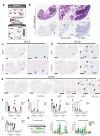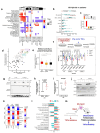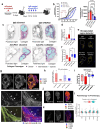This is a preprint.
Transitory Schwann Cell Precursor and hybrid states underpin melanoma therapy resistance and metastasis
- PMID: 40777322
- PMCID: PMC12330744
- DOI: 10.1101/2022.10.14.512297
Transitory Schwann Cell Precursor and hybrid states underpin melanoma therapy resistance and metastasis
Abstract
Melanoma plasticity, driven by phenotype state switching, underlies clinically relevant traits such as metastasis and therapy resistance. As melanoma progression is thought to recapitulate aspects of neural crest cell (NCC) development, understanding embryonic melanocyte specification and lineage fate decisions of closely related NCCs may illuminate the pathways co-opted during disease evolution. Here, we use a mouse model to isolate and sequence Dopachrome tautomerase (Dct) expressing NCCs, the precursors of melanocytes, at two key developmental stages. We classify these lineages and devise a Developmental Gene Module (DGM) scoring system to interrogate lineage state switching in melanoma samples. In bulk transcriptomes, activation of DGMs representing embryonic Schwann Cell Precursors (SCPs)-multipotent stem cells-in patient tumors predicts poor response to immune checkpoint inhibitors (ICI). Co-activation of SCP and Mesenchymal-like (Mes.) modules further correlates with resistance to MAPK inhibitors. Notably, single-cell analyses reveal that melanoma cells can simultaneously express multiple DGMs, forming "hybrid" states. Cells in a hybrid Neural/SCP state are enriched in early metastasis and ICI-resistant tumors and are insensitive to inflammatory stimuli. We demonstrate that targeting Hdac2, a histone deacetylase associated with this Neural/SCP hybrid state, promotes a mesenchymal-like state switch, remodels the tumor microenvironment, and sensitizes melanoma cells to TNFα and tumors to ICI therapy. Our methodology thus reveals dynamic patterns of lineage state switching correlated with melanoma tumor evolution to drive insight into new therapeutic targets.
Conflict of interest statement
Conflicts of Interest The authors declare no conflicts of interest.
Figures






References
Publication types
Grants and funding
LinkOut - more resources
Full Text Sources
Research Materials
Miscellaneous
